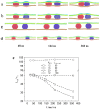Long-Range Interactions Between Neighboring Nanoparticles Tuned by Confining Membranes
- PMID: 40559275
- PMCID: PMC12196260
- DOI: 10.3390/nano15120912
Long-Range Interactions Between Neighboring Nanoparticles Tuned by Confining Membranes
Abstract
Membrane tubes, a class of soft biological confinement for ubiquitous transport intermediates, are essential for cell trafficking and intercellular communication. However, the confinement interaction and directional migration of diffusive nanoparticles (NPs) are widely dismissed as improbable due to the surrounding environment compressive force. Here, combined with the mechanics analysis of nanoparticles (such as extracellular vesicles, EVs) to study their interaction in confinement, we perform dissipative particle dynamics (DPD) simulations to construct a model that is as large as possible to clarify the submissive behavior of NPs. Both molecular simulations and mechanical analysis revealed that the interactions between NPs are controlled by confinement deformation and the centroid distance of the NPs. When the centroid distance exceeds a threshold value, the degree of crowding variation becomes invalid for NPs motion. The above conclusions are further supported by the observed dynamics of multiple NPs under confinement. These findings provide new insights into the physical mechanism, revealing that the confinement squeeze generated by asymmetric deformation serves as the key factor governing the directional movement of the NPs. Therefore, the constraints acting on NPs differ between rigid confinement and soft confinement environments, with NPs maintaining relative stillness in rigid confinement.
Keywords: confining membrane; dissipative particle dynamics simulations; long-range interactions; nanoparticles.
Conflict of interest statement
The authors declare no competing financial interests or personal relationships that could have appeared to influence the work reported in this paper.
Figures







Similar articles
-
Intravenous magnesium sulphate and sotalol for prevention of atrial fibrillation after coronary artery bypass surgery: a systematic review and economic evaluation.Health Technol Assess. 2008 Jun;12(28):iii-iv, ix-95. doi: 10.3310/hta12280. Health Technol Assess. 2008. PMID: 18547499
-
Home treatment for mental health problems: a systematic review.Health Technol Assess. 2001;5(15):1-139. doi: 10.3310/hta5150. Health Technol Assess. 2001. PMID: 11532236
-
Comparison of cellulose, modified cellulose and synthetic membranes in the haemodialysis of patients with end-stage renal disease.Cochrane Database Syst Rev. 2001;(3):CD003234. doi: 10.1002/14651858.CD003234. Cochrane Database Syst Rev. 2001. Update in: Cochrane Database Syst Rev. 2005 Jul 20;(3):CD003234. doi: 10.1002/14651858.CD003234.pub2. PMID: 11687058 Updated.
-
Maternal and neonatal outcomes of elective induction of labor.Evid Rep Technol Assess (Full Rep). 2009 Mar;(176):1-257. Evid Rep Technol Assess (Full Rep). 2009. PMID: 19408970 Free PMC article.
-
Incentives for preventing smoking in children and adolescents.Cochrane Database Syst Rev. 2017 Jun 6;6(6):CD008645. doi: 10.1002/14651858.CD008645.pub3. Cochrane Database Syst Rev. 2017. PMID: 28585288 Free PMC article.
References
Grants and funding
LinkOut - more resources
Full Text Sources

